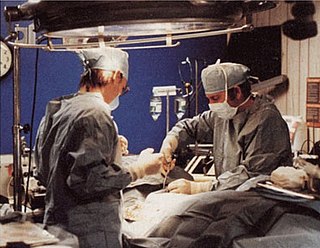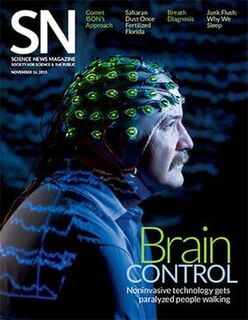
Sir Clive William John Granger was a British econometrician known for his contributions to non-linear time series. He taught in Britain at the University of Nottingham and in the United States at the University of California, San Diego. In 2003, Granger was awarded the Nobel Memorial Prize in Economic Sciences, in recognition that he and his co-winner, Robert F. Engle, had made contributions to the analysis of time series data that had changed fundamentally the way in which economists analyse financial and macroeconomic data.

Robert Chester Wilson Ettinger was an American academic, known as "the father of cryonics" because of the impact of his 1962 book The Prospect of Immortality.

The Box Tops is an American rock band, formed in Memphis in 1967. They are best known for the hits "The Letter", "Cry Like a Baby", and "Soul Deep" and are considered a major blue-eyed soul group of the period. They performed a mixture of current soul music songs by artists such as James & Bobby Purify and Clifford Curry; pop tunes such as "A Whiter Shade of Pale" by Keith Reid, Gary Brooker, and Matthew Fisher of Procol Harum; and songs written by their producers, Dan Penn, Spooner Oldham, and Chips Moman. Vocalist Alex Chilton went on to front the power pop band Big Star and to launch a career as a solo artist, during which he occasionally performed songs he had sung with the Box Tops.

Robin Dale Hanson is an associate professor of economics at George Mason University and a research associate at the Future of Humanity Institute of Oxford University. He is known as an expert on idea futures and markets, and he was involved in the creation of the Foresight Institute's Foresight Exchange and DARPA’s FutureMAP project. He invented market scoring rules like LMSR used by prediction markets such as Consensus Point, and has conducted research on signalling.

Morphological analysis or general morphological analysis is a method developed by Fritz Zwicky for exploring all the possible solutions to a multi-dimensional, non-quantified complex problem.

Erich Jantsch was an Austrian-born American astrophysicist, engineer, educator, author, consultant and futurist, especially known for his work in the social systems design movement in Europe in the 1970s.
Technological Forecasting and Social Change is a peer-reviewed academic journal published by Elsevier which discusses futures studies, technology assessment, and technological forecasting. Articles focus on methodology and actual practice, and have been published since 1969.
James Hiram Bedford was an American psychology professor at the University of California who wrote several books on occupational counseling. He is the first person whose body was cryopreserved after legal death, and who remains preserved at the Alcor Life Extension Foundation.
The American Cryonics Society (ACS), also known as the Cryonics Society of America, is a member-run, California-based, 501(c)(3) tax-exempt nonprofit organization that supports and promotes research and education into cryonics and cryobiology. Cryonics is the preservation through cold storage, usually with liquid nitrogen, of humans after legal death. This procedure is done in the hopes of eventual "reanimation." Any such reanimation depends upon future technological advances that are hoped for, but by no means assured or promised.
Jerry Donnell Leaf was Vice President and Director of the cryonics organization Alcor Life Extension Foundation, and President of the cryonics service firm Cryovita, Inc. until his cryopreservation by Alcor following a fatal heart attack in 1991.
Curtis Henderson was a pioneer in the practice of cryonics.
Saul Kent is a life extension activist, and co-founder of the Life Extension Foundation, a dietary supplement vendor and promoter of anti-aging research. He is also a pioneer in the practice of cryonics, and is a former board member of the cryonics organization Alcor Life Extension Foundation, which has no connection to the Life Extension Foundation.
Frederick Rockwell Chamberlain III and his wife Linda were the founders of the cryonics organization Alcor Life Extension Foundation. Their long and continued history of activism in cryonics make them among the most well-known cryonics pioneers. David Pascal wrote in the November/December 2005 issue of the Mensa Bulletin that, second to the man credited with the original idea for cryonics, Robert Ettinger, the Chamberlains have contributed more than anyone to the field of cryonics.
Chiltons is an unincorporated community in Westmoreland County, in the U. S. state of Virginia.
The Life Extension Society (LES) with its network of coordinators was the first cryonics organization in the world. It was founded by Evan Cooper in 1964 to promote cryonic suspension of people, and became the seed tree for cryonics societies throughout the USA where local cryonics advocates would meet as a result of contact through the LES mailing list. The original LES ceased existence near the end of the 1960s, but an organization with the same name and similar objectives was incorporated in Maryland in 1992.
Tessaleno Campos Devezas is a Brazilian-born Portuguese physicist, systems theorist, and materials scientist. He is best known for his contributions to the long waves theory in socioeconomic development, technological evolution, energy systems as well as world system analysis.

William Alexander "Alex" Chilton was an American singer-songwriter, guitarist, and record producer, best known as the lead singer of The Box Tops and Big Star. Chilton's early commercial success in the 1960s as a teen vocalist for The Box Tops was never repeated in later years with Big Star and in his subsequent indie music solo career on small labels, but he drew an intense following among indie and alternative music musicians. He is frequently cited as a seminal influence by influential rock artists and bands, some of whose testimonials appeared in the 2012 documentary Big Star: Nothing Can Hurt Me.
Shannon Vyff is an American transhumanist, cryonicist, and author. She is a director of both the Immortality Institute and the Society for Venturism.

Cryonics Institute (CI) is an American not-for-profit corporation that provides cryonics services. CI preserves humans and pets in liquid nitrogen after death with hopes of restoring them when new technology will be developed in the future.










